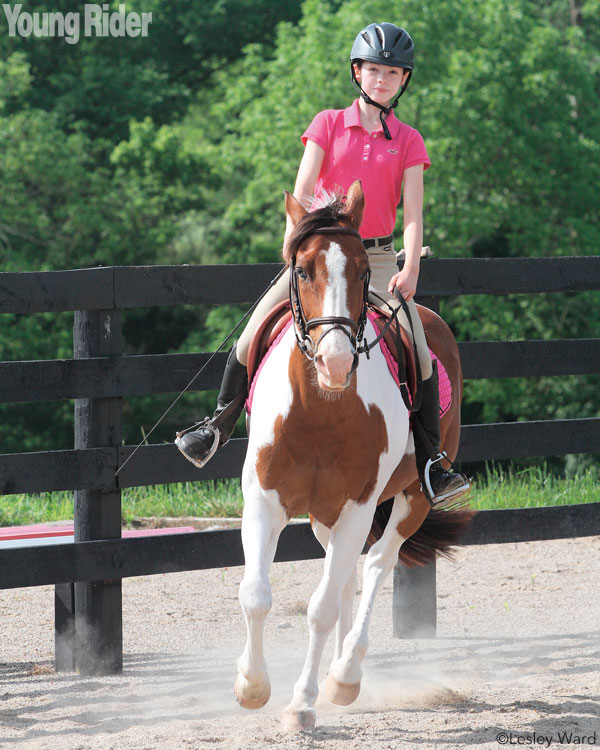It’s frustrating when your horse won’t pick up the correct canter lead consistently.
Cantering on the wrong lead will lose you points during a dressage test and it can knock you out of the ribbons in a hunter class.
When you canter, there’s always a leading leg; one that stretches out further than the other leg, and it’s usually the inside leg if you’re riding in an arena. If you’re going around the arena in the left direction, your horse’s front left leg should lead at the canter.
If you’re going around to the right, your horse’s front right leg should lead.
To make it simple—your horse’s inside foreleg should always be leading at the canter.
If your horse is on the wrong lead, his balance could be affected and it may be difficult for him to perform dressage movements or jump.
Lunge test
Generally, if a horse is having lead problems the rider is the problem. Either you’re not giving the correct aids or you’re not asking for the canter at the right time. But sometimes, equine leg or back issues may cause cantering problems.
If your horse doesn’t pick up the correct lead frequently, canter him on a lunge line. If he picks up the correct lead in both directions, the problem is probably the person on his back—you!
If he’s still having lead problems, he may have a physical problem that needs veterinary care. Set up an appointment with your veterinarian to examine your horse. She’ll want to see your horse on the lunge line and she may want to watch you ride him.
Prepare to canter
If your horse is poking along at a slow trot, this is not the time to ask for the canter. Your horse should be doing a forward, rhythmic trot that’s full of energy before you give the aids to canter.
The best place to ask for the canter is on a circle, so choose a corner of the arena or field and begin trotting in a 20-meter circle. If your horse is being lazy, do some transitions to wake him up.
In order for him to take off on the inside leg, flex his head slightly to the inside. Make sure that you don’t lean to the inside though. Sit up straight.
Put a little more weight into your inside stirrup and begin doing sitting trot.
Place your inside leg at the girth and your outside leg behind the girth. If you’re having major lead problems, exaggerate your outside leg by pushing it back about five inches behind the girth and then bump him firmly with it to ask him to strike off.
Wrong lead!
If your horse picks up the wrong lead, don’t get mad and yank him back to a trot and ask him to canter again. Let him canter a few strides. Let him know that you’re pleased he reacted quickly to your leg. Then, quietly ask him to come back to trot, continue circling and when he’s balanced ask for the canter again.
When he picks up the correct lead, stay on the circle for a few loops until you feel balanced enough before you set off around the arena.
Pole exercise
To help your horse pick up the correct lead, put a pole down in the corner of the arena. Imagine that it’s part of a 20-meter circle so flex your horse slightly to the inside as you approach it at the trot. Right before you reach the pole, ask your horse to canter. Most horses will jump the pole and land on the correct lead. If your horse doesn’t pick up the correct lead, repeat this exercise several times. If he picks up the correct lead, continue cantering around the arena.
Spiral in, spiral out
Another exercise you can do to help get the correct lead is to use spirals. Begin trotting in a 20-meter circle in the corner of the arena or field. Once you’ve established a nice, bouncy, active trot, ask your horse to spiral in to a 10-meter circle by leg yielding. Use your outside leg to push him into the circle as you spiral. After you trot one or two 10-meter circles, use your inside leg to push him back out to the 20-meter circle. Just as you reach the 20-meter circle, flex his head slightly to the inside, bring your outside leg back a bit and bump him with it to ask him to canter. If he’s paying attention to your aids and you’re giving them correctly, he should take off on the correct lead.
Common canter problems
Here are some other things that might be causing your horse to take the wrong lead:
Your horse is stiff. Do some carrot stretches before you ride and do lots of circles and turns when you’re in the saddle to help him become more flexible.
You’re pulling on the inside rein too much. Flex his neck slightly. Squeeze on the rein, don’t pull.
You’re leaning too much to one side. Sit up straight and stay balanced in the saddle.
You’re tense. Relax and ask for the canter quietly. Don’t assume he’s going to strike off on the wrong lead and stress out before you even give the aids to canter. Remember, if you stiffen up, your horse will too.
FYI: Off the track Thoroughbreds
While they’re in training, young Thoroughbreds are often cantered to the left–the direction in which they race. This means that by the time they finish racing and end up with you, they haven’t cantered to the right very much and they may have a hard time picking up the right lead.
Be extra patient with an off-the-track Thoroughbred. Spend lots of time walking and trotting in both directions. Do lots of circles and serpentines to help your horse become suppler. And let him do a bit of calm cantering on a lunge line before you ask for it under saddle.



